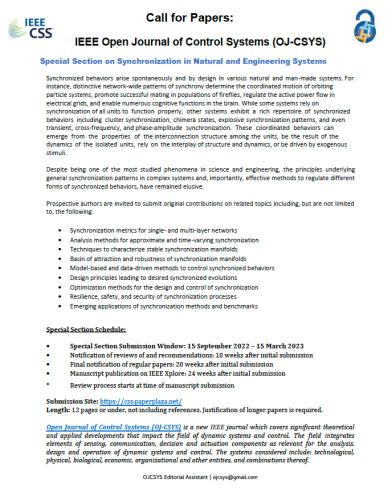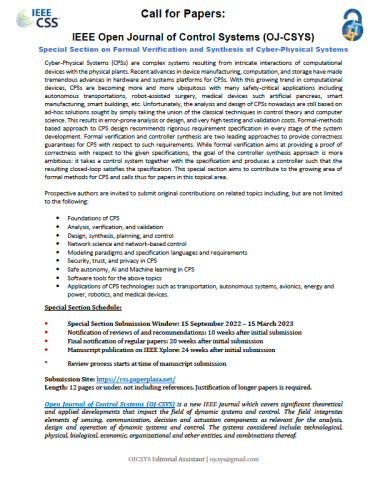Intersection on Machine Learning with Control (Recurring)
Special Section Editor: Lacra Pavel
Submission Window: September 15, 2022 – April 30, 2023
Submission Site: https://css.paperplaza.net/
Topics of interest for this special issue include and are not limited to:
Machine learning for dimensionality reduction and system identification
Emerging applications for learning-based control
Data-driven optimization and control for dynamical systems
Safe reinforcement learning and safe adaptive control
Bridging model-based and learning-based control systems
Distributed learning over distributed systems
Reinforcement learning for multiagent systems
Optimization, dynamics and control for machine learning
Reinforcement learning and statistical learning for dynamical and control systems
Formal Verification and Synthesis of Cyber-Physical Systems
Special Section Editor: Majid Zamani
Submission Window: September 15, 2022 – March 15, 2023
Submission Site: https://css.paperplaza.net/
Topics of interest for this special issue include and are not limited to:
Foundations of CPS
Analysis, verification, and validation
Design, synthesis, planning, and control
Network science and network-based control
Modeling paradigms and specification languages and requirements
Security, trust, and privacy in CPS
Safe autonomy, AI and Machine learning in CPS
Software tools for the above topics
Applications of CPS technologies such as transportation, autonomous systems, avionics, energy and power, robotics, and medical devices.
Synchronization in Natural and Engineering Systems
Special Section Editor: Fabio Pasqualetti
Submission Window: September 15, 2022 – March 15, 2023
Submission Site: https://css.paperplaza.net/
Topics of interest for this special issue include and are not limited to:
Synchronization metrics for single- and multi-layer networks
Analysis methods for approximate and time-varying synchronization
Techniques to characterize stable synchronization manifolds
Basin of attraction and robustness of synchronization manifolds
Model-based and data-driven methods to control synchronized behaviors
Design principles leading to desired synchronized evolutions
Optimization methods for the design and control of synchronization
Resilience, safety, and security of synchronization processes
Emerging applications of synchronization methods and benchmarks
See attached for flyers, and please contact the editorial assistant with any questions: ojscys@gmail.com


